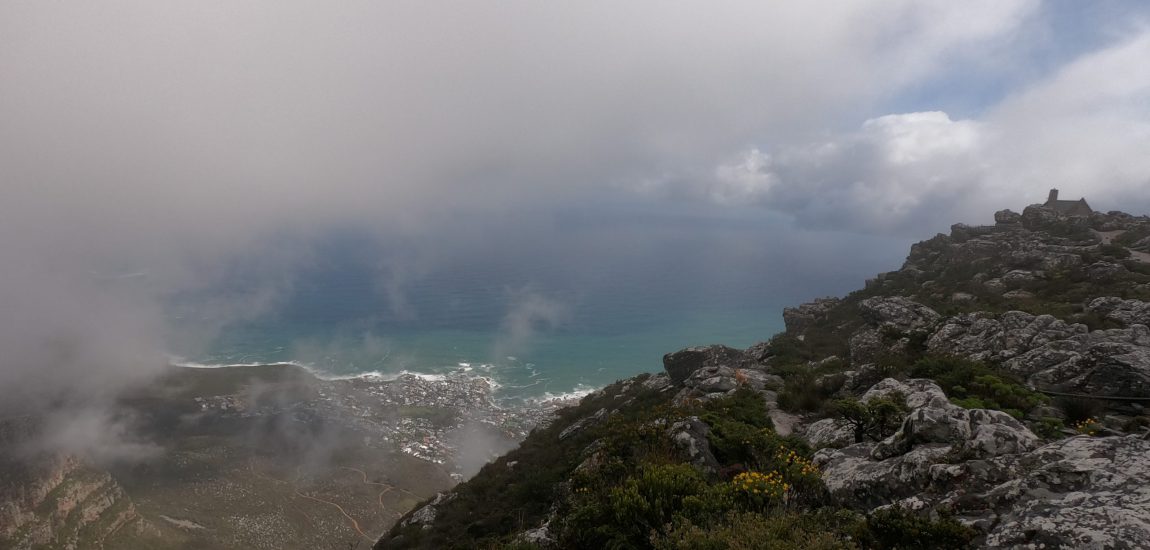
How isotopes can help us understand Cape Town’s water crisis
Rosy Finlayson, Ayabonga Mtsotso and Nomvo Kasolo
The water crisis
Cape Town experienced one of its worst droughts on record from 2015 to 2018, culminating in a threat to cut off municipal water supply to over 4 million people (nicknamed “Day-Zero”). To avoid this, the City of Cape Town (CoCT) implemented extreme water restrictions. This exacerbated unequal access to water – a basic human right. Water shortages are predicted to become increasingly common in Cape Town due to climate change and rising demand for water from a growing population. An understanding of the local hydrology is critical to manage water resources effectively and avoid another “Day-Zero” scenario.
In the past, isotope studies have been used to investigate surface water (dams, reservoirs and rivers) and its sources (rainfall, and more rarely, in the Western Cape, snow and hail). The drought predominantly impacted surface water systems, which led the CoCT to investigate alternative sources of water such as groundwater. For our Honours research projects, we are determining the stable isotope composition of local precipitation, the springs at the foot of Table Mountain and the Cape Flats aquifers to broaden our understanding of Cape Town’s hydrological system. This information will assist with planning long and short-term water management policies.
Local hydrology
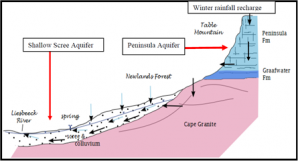
Cape Town has a Mediterranean-type climate. It experiences cool, wet winters and warm, dry summers. The Western Cape water system is primarily reliant on rainfall, making the CoCT highly vulnerable to climate perturbations. There are two main aquifers that have been identified as alternative sources of water by the CoCT: The Table Mountain Group and Cape Flats aquifers. The Table Mountain Group Aquifer has recently been tapped and is thought to contain billions of cubic meters of fresh water. The Cape Flats Aquifer also has the potential to produce high yield boreholes.
How isotopes can help
We will be using oxygen (δ18O) and hydrogen (δD) isotopes, which are stable and are conservative tracers in this context. They have been widely used in the field of hydrogeology because their fractionations in the water cycle are predictable and well understood. Since water of different origin has distinct oxygen and hydrogen isotope composition, the isotope ratios can be used to trace water masses and quantify contributions from different sources. For instance, groundwater movement can be tracked by comparing the isotope composition of local rainfall and spring water. Stable isotopes can also be used along with other tracers to identify leaks from water mains, pollution of groundwater by sewage and seawater intrusion, as well as to estimate aquifer recharge rates.
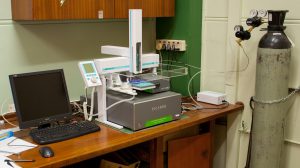
Rainfall patterns
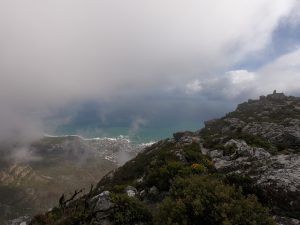
The isotope composition of rainfall collected over a 12-year period at the University of Cape Town between 1996 and 2008 has been used to distinguish between orographic rain and frontal rain. Frontal rain provides more water for the CoCT, and there were no systematic variations in the abundance, mean temperature and isotope compositions over that period (Harris et al., 2010).
However, none of the studies could fully test hypotheses about climate change because of their short time frames. We plan to analyse and compare unpublished rainfall data (2008–2020) with earlier rainfall data (1996–2008) to assess changes in isotope composition leading up to the drought and through the recovery period. We will compare the isotope composition and deuterium excess (=δD – 8δ18O), with the amount of rainfall and the temperature. We hope the results will reveal how the drought influenced the isotope composition, opening up the possibility of detecting historical droughts in proxy archives such as stalagmites.
Groundwater systems
Oxygen and hydrogen isotopes may also give insight into the recharge rates, extent and connectivity of the Table Mountain and the Cape Flats aquifers (Harris et al., 1999; Harris, 2017). Recharge rates can be estimated by comparing the groundwater to the local precipitation. Aquifers with rapid recharge rates have oxygen and hydrogen isotope values that are very similar to the local precipitation. If they have very different ratios from recent precipitation this indicates that the aquifer contains ancient waters.
For example, the oxygen and hydrogen isotope ratios of a shallow scree/colluvium aquifer (Fig. 1) in Constantia, a suburb of Cape Town (11 Km south of the city centre), is distinct from the nearby springs at the foot of Table Mountain (Harris, 2017). Constantia groundwater instead has an isotope signature close to the weighted mean annual rainfall for 2013 (Harris et al., 2010). The recharge rates must therefore be slower than the springs, which have isotope ratios that are similar to rainfall from more recent years. About half of the water in the aquifers feeding the springs along the lower slopes of Table Mountain is estimated to be recharged within 2 years (Harris et al., 2010), but repeated measurements over a period of months and years are needed to verify this.
Isotopic data also track the mean altitude of recharge, since recharge at higher altitudes results in more negative isotopic values. For instance, the altitude of recharge for the Mains Spring is higher than that of Albion Spring at the foot of Table Mountain on the E side, and it has more negative isotopic values (Harris, 2017).
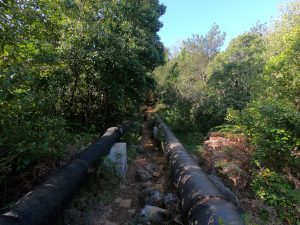
Water leaks
Considerable efforts were made to curb industrial and domestic water demand during the drought, reducing daily water usage by around a half, but around a third of South Africa’s clean water supply is lost through leaks and burst pipes. Identifying these is therefore a priority for the CoCT. If the oxygen and hydrogen isotope composition of a water sample lies between that of the groundwater and tap water this would suggest mixing of the groundwater with municipal water due to leakage.
Conclusion
Groundwater has been suggested as an alternative source of water to supplement the dams that supply water to the Western Cape. The location and the number of primary aquifers, source of aquifer recharge and rate of recharge need to be monitored to ensure sustainable water extraction over time. Isotopes provide an important geochemical tool to help us understand and manage Cape Town’s water supply.
References
Diamond, R. 2014. Stable isotope hydrology of the Table Mountain group. PhD Thesis, University of Cape Town.
Harris, C., Oom, B.M. & Diamond, R.E. 1999. A preliminary investigation of the oxygen and hydrogen isotope hydrology of the greater Cape Town area and an assessment of the potential for using stable isotopes as tracers. Water SA. 25(1): 15-24.
Harris, C., Burgers, C., Miller, J. & Rawoot, F. 2010. O-and H-isotope record of Cape Town rainfall from 1996 to 2008, and its application to recharge studies of Table Mountain groundwater, South Africa. South African Journal of Geology.113: 33-56.
Harris, C. 2017. Report on the stable isotope composition of groundwater in the Constantia area [unpublished report]. Department of Geological Sciences, University of Cape Town.
About the authors
The authors are all honours geology students at the University of Cape Town, South Africa.

Rosy Finlayson is investigating the spatial analysis of oxygen, hydrogen and strontium isotope ratios in groundwater across the Southern Suburbs and Cape Flats, Cape Town. She is planning to further her studies in a Master’s degree next year.
Ayabonga Afika Mtsotso is investigating the recharge rates of the springs on the lower slopes of Table Mountain. This is a means to gain better understanding of the Table Mountain aquifer and its ability to withstand large water extraction. She is passionate about nature and in her spare time she enjoys hiking and reading non-fiction books.


Nomvo Faith Kasolo has a key interest in hydrogeology and isotope geochemistry, hence her project focusing on rainfall pattern changes in Cape Town. She is also passionate about using science in developmental studies and plans on doing an MPhil in Environment, Society and Sustainability in 2021. Outside of school, she writes for her personal blog on https://medium.com/@stories4africa.
